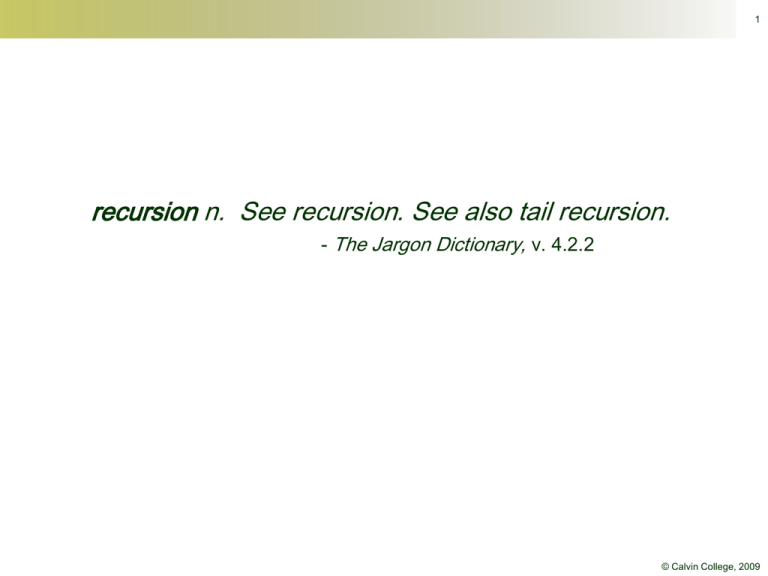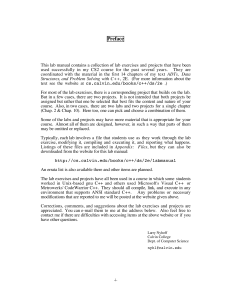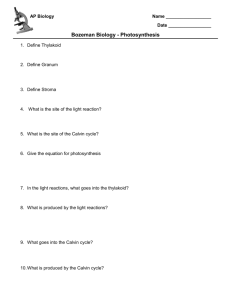recursion n. See recursion. See also tail recursion. - v. 4.2.2
advertisement

1
recursion n. See recursion. See also tail recursion.
- The Jargon Dictionary, v. 4.2.2
© Calvin College, 2009
2
Additional Control Structures
●
Advanced control statements:
–
Selection: Switch statement;
– Repetition: Non-counting loops.
●
Recursion
© Calvin College, 2009
3
The switch Statement
●
Multi-alternative selection can be
implemented using:
The multi-branch if statement
– The switch statement
–
●
●
The multi-branch if statement can always
be used.
The switch statement is a specialized
form that operates more efficiently under
certain circumstances.
© Calvin College, 2009
4
switch: Syntax and Behavior
switch (expression) {
case value1:
statementList1
case value2:
statementList2
…
default:
statementListn
}
Requirements:
●
●
●
expression
value1 StatementList1
value2 StatementList2
otherwise
StatementListn
expression must be integer compatible;
values must be constants or literals;
Cases check for equality.
© Calvin College, 2009
5
switch & if: Examples
if (dayCode == 1) {
System.out.println("Sunday");
} else if (dayCode == 2) {
System.out.println("Monday");
} else if (dayCode == 3) {
System.out.println("Tuesday");
} else if (dayCode == 4) {
System.out.println("Wednesday");
} else if (dayCode == 5) {
System.out.println("Thursday");
} else if (dayCode == 6) {
System.out.println("Friday");
} else if (dayCode == 7) {
System.out.println("Saturday");
} else {
System.out.println("invalid code);
}
switch (dayCode) {
case 1:
System.out.println("Sunday");
break;
case 2:
System.out.println("Monday");
break;
case 3:
System.out.println("Tuesday");
break;
case 4:
System.out.println("Wednesday");
break;
case 5:
System.out.println("Thursday");
break;
case 6:
System.out.println("Friday");
break;
case 7:
System.out.println("Saturday");
break;
default:
System.out.println("invalid code");
}
© Calvin College, 2009
6
switch: Fall-Through Behavior
●
●
●
The switch statement implemented fallthrough behavior.
More than one case can be associated
with one statement list.
If only one list is to be executed, then that
list must explicitly exit the switch using:
–
–
–
–
break
return
throw
exit
© Calvin College, 2009
7
switch: Examples
switch (dayCode) {
case 1:
System.out.println("Sunday");
break;
case 2:
System.out.println("Monday");
break;
case 3:
System.out.println("Tuesday");
break;
case 4:
System.out.println("Wednesday");
break;
case 5:
System.out.println("Thursday");
break;
case 6:
System.out.println("Friday");
break;
case 7:
System.out.println("Saturday");
break;
default:
System.out.println("invalid code");
}
switch (dayCode) {
case 1:
case 7:
System.out.println("weekend");
break;
case 2:
case 3:
case 4:
case 5:
case 6:
System.out.println("weekday");
break;
default:
System.out.println("invalid code");
}
© Calvin College, 2009
11
Non-Counting Loops
●
So far, we’ve used counting for loops.
●
There are other repetition statements:
while statement
– do-while statement
–
–
Forever loop
© Calvin College, 2009
12
The while Loop
A while loop executes a statement based
on a boolean condition.
while (condition)
statement
False
condition
True
Statement
© Calvin College, 2009
13
while: Example
System.out.print("Guess a number from 1-10: ");
int number = -1;
while (number != 7) {
number = keyboard.nextInt();
}
System.out.println("You guessed it!");
© Calvin College, 2009
14
The do-while Loop
A do-while loop is a post-test version of
the while statement.
do
statement
while (condition);
statement
condition
True
False
© Calvin College, 2009
15
do-while: Example
System.out.print("Guess a number from 1-10: ");
do {
number = keyboard.nextInt();
} while (number != 7);
System.out.println("You guessed it!");
© Calvin College, 2009
16
The Forever Loop
A for loop without the sub-expressions is
a non-counting, non-conditional loop.
while (true) {
StatementList1
if (ExitCondition)
break;
StatementList2
}
StatementList1
True
ExitCondition
False
StatementList2
© Calvin College, 2009
17
Forever Example
System.out.print("Guess a number from 1-10 (0
to give up): ");
while (true) {
number = keyboard.nextInt();
if (number == 7) {
System.out.println("You guessed it!");
break;
} else if (number == 0) {
System.out.println("Quitter!");
break;
}
System.out.print("try again: ");
}
© Calvin College, 2009
18
while: Example
public static int computeGCD(int a, int b)
throws Exception {
if ((a <= 0) || (b <= 0)) {
throw new Exception("illegal values");
}
int remainder = 1;
while (remainder != 0) {
remainder = a % b;
if (remainder == 0) {
return b;
} else {
a = b;
b = remainder;
}
}
return 0;
}
© Calvin College, 2009
20
Recursion
●
●
Introduction
Examples:
–
Factorial;
– Towers of Hanoi;
– Graphical examples.
●
Lisp
© Calvin College, 2009
21
Introduction
Recursion is a way of defining
functions self-referentially.
● Examples:
●
–
Droste effect;
– (Parenthetical comments (especially
comments within comments), etc.);
– A chain of phone callers on hold;
– Inductive Proofs.
Image from google.com
© Calvin College, 2009
22
from The Cat in the Hat Comes Back, Dr. Seuss
© Calvin College, 2009
23
Example: Factorial
●
●
●
Write a function that, given n, computes n!
n! == 1 * 2 * ... * (n-1) * n
Example:
5! == 1 * 2 * 3 * 4 * 5 == 120
Assumptions:
–
Receive n, a non-negative integer.
– Return n!, a double (to avoid integer overflow).
© Calvin College, 2009
24
Preliminary Analysis
●
This can be viewed as a counting problem,
so we could solve it iteratively:
public static int factorial1(int n){
int result = 1;
for (int i = 2; i <= n; i++)
result *= i;
return result;
}
© Calvin College, 2009
25
An Alternate Analysis
●
Consider the following alternate analysis:
n!
== 1 * 2 * ... * (n-1) * n
(n-1)! == 1 * 2 * ... * (n-1)
n!
== (n-1)! * n
●
Historically, this is how the factorial function was
defined.
© Calvin College, 2009
The Mechanics of Recursion
Design recursive functions using a threestep process:
1. Identify a base case - an instance of
the problem whose solution is trivial.
E.g., The factorial function has two
base cases:
if n == 0: n! == 1
if n == 1: n! == 1
from The Cat in the Hat Comes Back, Dr. Seuss
© Calvin College, 2009
Mechanics (cont.)
2. Identify an induction step - a means of
solving the non-trivial instances of the
problem using one or more “smaller”
instances of the problem. E.g.,
n! == (n-1)! * n
from The Cat in the Hat Comes Back, Dr. Seuss
© Calvin College, 2009
Mechanics (cont.)
3. Form an algorithm that includes the
base case and induction step, and
ensures that each inductive step moves
toward the base case.
factorial:
Receive n.
If n > 1 then
Return factorial(n-1) * n.
Else
Return 1.
from The Cat in the Hat Comes Back, Dr. Seuss
© Calvin College, 2009
Implementation
public static int factorial(int n) {
if (n > 1)
return factorial(n-1) * n;
else
return 1;
}
© Calvin College, 2009
Example: Towers of Hanoi
●
●
Move disks from a source pin to a target
pin, using the third pin as an auxiliary.
Rules:
move only one disk at a time;
– never put a larger disk onto a smaller one.
–
© Calvin College, 2009
Design
●
●
Today’s problem is to write a program that
generates the instructions for the priests to
follow in moving the disks.
While quite difficult to solve iteratively, this
problem has a simple and elegant
recursive solution.
© Calvin College, 2009
Driver Program
public static void main (String [] args) {
Scanner keyboard = new Scanner(System.in);
System.out.println("The Hanoi Towers\n");
System.out.print("number of disks: ");
int n = keyboard.nextInt();
move(n, 'A', 'B', 'C');
}
© Calvin College, 2009
Design (cont.)
●
Base case:
●
Inductive case:
© Calvin College, 2009
Algorithm
We can combine these steps into the following
algorithm:
0. Receive n, src, dest, aux.
1. If n > 1:
a. move(n-1, src, aux, dest);
b. move(1, src, dest, aux);
c. move(n-1, aux, dest, src);
Else
Display “Move the top disk from ” + src + “ to ” + dest.
© Calvin College, 2009
Implementation
public static void move(int n, char src, char dest, char aux) {
if (n > 1) {
move(n-1, src, aux, dest);
move(1, src, dest, aux);
move(n-1, aux, dest, src);
} else
System.out.println("Move the top disk from " +
src + " to " + dest);
}
}
© Calvin College, 2009
Algorithm Analysis
How many “moves” does it take to solve this problem
as a function of n, the number of disks to be moved.
n
1
2
3
4
5
...
i
64
# of moves required______
1
3
7
15
31
2i-1
264-1
© Calvin College, 2009
Analysis (cont.)
Given a “super-printer” that can generate and print
1,048,576 (220) instructions/second, how long
would it take to print 264-1 instructions?
264/220 = 244 seconds
@ 244 / 26 = 238 minutes
@ 238 / 26 = 232 hours
@ 232 / 25 = 227 days
@ 227 / 29 = 218 years
@ 218 / 27 = 211 centuries
@ 211 / 24 = 27 = 128 millennia
© Calvin College, 2009
38
Graphical Examples
●
Sierpinski triangles
●
Tree fractals
●
Koch’s snowflake
© Calvin College, 2009
39
John McCarthy
What’s the
Big Idea
Artificial Intelligence
●
●
McCarthy received the Turing award in
1971 for his seminal contributions to AI
(including the name of the field).
He developed Lisp, one of the oldest
programming languages.
(defun reverse (l acc)
“reverses the order of the element of L”
(if (null l)
acc
(reverse (cdr l) (cons (car l) acc))))
from http://www-formal.stanford.edu/
© Calvin College, 2009




